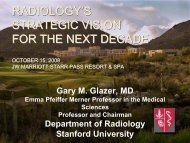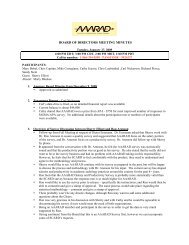Radiology in 2020 - Aaarad.org
Radiology in 2020 - Aaarad.org
Radiology in 2020 - Aaarad.org
- No tags were found...
Create successful ePaper yourself
Turn your PDF publications into a flip-book with our unique Google optimized e-Paper software.
<strong>Radiology</strong> <strong>2020</strong>A Guid<strong>in</strong>g Look AheadNorman J. Beauchamp, Jr. MD MHSProfessor and ChairmanDepartment of <strong>Radiology</strong> and Imag<strong>in</strong>g SciencesProfessor of Neurological Surgery andIndustrial Eng<strong>in</strong>eer<strong>in</strong>gUniversity of Wash<strong>in</strong>gton
When Chris and I were firstcontacted to del<strong>in</strong>eate thefuture… our next step seemed• Ask THEInternationalop<strong>in</strong>ion leader!!!“already work<strong>in</strong>gwith anotherspeaker”clear….
“Study the past if you woulddef<strong>in</strong>e the future. “ConfuciusCh<strong>in</strong>ese philosopher & reformer(551 BC ‐ 479 BC)
Look back to 1996
Technology <strong>in</strong> 1996EV1 - first modern production electric vehicle from a majorautomaker and also the first purpose-built electric car produced
Healthcare 1996“Managed care willreduce health carecosts… by controll<strong>in</strong>gaccess to resources.”
Healthcare & <strong>Radiology</strong> 1996“Cost imperative can bemet through leverag<strong>in</strong>gIT and improv<strong>in</strong>gefficiency.”
1996 Predictions of the Future"Health Care Cybervision: TheRole of the Internet <strong>in</strong> HealthCare," - co-sponsored by Internettechnology leaders SunMicrosystems, Ernst & YoungLLP, Sybase, Inc., Spr<strong>in</strong>tInternational and 3Com.
Healthcare & <strong>Radiology</strong> 1996“<strong>Radiology</strong> departmentswill demonstrateefficiency, quality controland cost-effectiveness.”
Healthcare & <strong>Radiology</strong> 1996“New imag<strong>in</strong>g technology willchange the educationalrequirements andemployment status ofradiologic technologists.”
1996 Predictions of the Future“The future of radiology will be <strong>in</strong><strong>in</strong>tegrated systems as<strong>in</strong>terconnectivity anddigitalization contribute to anetwork of compatible andcommunicat<strong>in</strong>g modalities likethose made possible throughPACS.”
“Study the past if youwould def<strong>in</strong>e thefuture. “Lesson not the expectedone….did not uncoverclues to determ<strong>in</strong>e thefuture of <strong>Radiology</strong>
“Study the past if youwould def<strong>in</strong>e thefuture. “The stated strategic plansmade backthen…rema<strong>in</strong> unrealizedNot due to a lackof importance
Predictions and StrategyDid not <strong>in</strong>spire the necessary response
Predictions and StrategyDid notmotivate asusta<strong>in</strong>edresponsethe first purpose-built electric car produced byGeneral Motors (GM) <strong>in</strong> the United States..made 1100
Predictions and Strategy“Managed care willreduce health carecosts by controll<strong>in</strong>gresources.”
Predictions and Strategy“<strong>Radiology</strong> departmentsmust demonstrateefficiency, quality controland cost-effectiveness.”R and D: Outcomes and Operations Research, Tools forCommunity of Researchers
Predictions and Strategy“New imag<strong>in</strong>g technology willchange the educationalrequirements andemployment status ofradiologic technologists.”
Predictions and Strategy“The future of radiology will be <strong>in</strong><strong>in</strong>tegrated systems as<strong>in</strong>terconnectivity anddigitalization contribute to anetwork of compatible andcommunicat<strong>in</strong>g modalities likethose made possible throughPACS.”
Healthcare Cybervision(one year later)• Despite the potential of the Internet andthe feverish application of Internetrelatedtechnology - <strong>in</strong> healthcare largely<strong>in</strong> a hold<strong>in</strong>g pattern.security issues as the major reasonfor hold<strong>in</strong>g back.
When it comes to mak<strong>in</strong>gpredictions for the purposesof strategic plann<strong>in</strong>g, we arepretty much wast<strong>in</strong>g ourtime...The Strategy ParadoxM. Raynor
Change Happens*
Punctuated Equilibriumpunctuationchangetimeequilibriumnot no activityHow Nature Works
Depends on the “slice” of time• Fuel efficient vehicles• Managed Care– Quality, safety and access as a primary focus– R and D– Outcomes– Technologist and Physician Tra<strong>in</strong><strong>in</strong>g• Healthcare CybervisionWe ebb and flow <strong>in</strong> our resolve
Change is a “Step‐Function”
Challenge is one of Tim<strong>in</strong>g• Are we on the “riser” or the “tread”?
And One of Prediction• When does the current “tread” end?
The future is a range of possible outcomes, not a specificset of circumstances that will <strong>in</strong>evitably come to pass.The Strategy ParadoxM. Raynor
It would be a mistake,however, to concludethat we have no <strong>in</strong>sight<strong>in</strong>to the future…The Strategy ParadoxM. Raynor
Prepare for Change
Environmental Influences• Healthcare costs cont<strong>in</strong>ue to rise– Societal obligation– Global responsibility• Technological advancement• Information technology pervades– Cont<strong>in</strong>ued avenue to ga<strong>in</strong> efficiencies• Role of regulation and government• Role of consumerism <strong>in</strong> healthcare– Balance of quality, productivity and value
The existence of strategic risk is a function of theunpredictability of the future. Consequently, manag<strong>in</strong>gstrategic risk cannot h<strong>in</strong>ge on improved prediction.However, it is possible to bound the range of possiblefutures that one might face. This is best done withscenarios.By creat<strong>in</strong>g a number of scenarios that def<strong>in</strong>e the“possibility space” over a relevant time horizon, one cancreate a framework for discuss<strong>in</strong>g the future withouthav<strong>in</strong>g to stake future success on guess<strong>in</strong>g right.The Strategy ParadoxM. Raynor
Scenarios• The goal is to def<strong>in</strong>e a few scenarios thatmake a difference to decision makers• A good scenario will lead us to betterquestions• A good scenario will lead us to susta<strong>in</strong>edappropriate action and reaction“STORIES STICK”
<strong>Radiology</strong> <strong>2020</strong>• “Use the Forces” ” (Free Market)• “Mov<strong>in</strong>g on up” (Governmental Control)• “Reverse Polarity” (Institutional Controls)NOTE THE CATCHY NAMES
Scenario I“Use the Forces”• The government, fac<strong>in</strong>ghealthcare costs consum<strong>in</strong>g23% of the GNP, hasdecided under PresidentRoss Perot that free marketcapitalism will reign and thata new era of deregulationwill commence.
Scenario I“Use the Forces”• The ubiquitous <strong>in</strong>ternet hasbroken down many protectionistbarriers, <strong>in</strong>clud<strong>in</strong>g those erectedby medical licensure.• Google’s health record has beena smash<strong>in</strong>g success hav<strong>in</strong>g beenadopted by 85 million people andsecurity concerns have beenassuaged.
Scenario I“Use the Forces”• The <strong>in</strong>ternet’s record ofreduc<strong>in</strong>g prices has beenimpressive.• The new mantra ishealthcare <strong>in</strong>formation andservices are only a “clickaway”.
Scenario I“Use the Forces”• Physicians will now be licensedacross state l<strong>in</strong>es and provision ofmedical services is nowunencumbered between all statesand U.S. Territories• Internet-based services arereimbursed and some are currentlyselectively even outsourcedglobally.
Scenario I“Use the Forces”• S<strong>in</strong>ce the FDA has begun to piggybackon EU approval of drugs, Medicare isconsider<strong>in</strong>g the same for physicianservices.• There is talk of further reduction <strong>in</strong>barriers to English speak<strong>in</strong>g physicians<strong>in</strong> Europe provid<strong>in</strong>g services <strong>in</strong> theUnited States.• Interventional procedures abroad arereimbursed for selected, approved sites.
Scenario I“Use the Forces”• E-Bay type markets have begun topop up for the provision of diagnosticservices, <strong>in</strong>clud<strong>in</strong>g lab and radiologicservices.• Ultrasound has become cheap, andlarge, flexible arrays are beg<strong>in</strong>n<strong>in</strong>g toreplace some CT and MR studies.• These <strong>in</strong>expensive, new devices arebe<strong>in</strong>g <strong>in</strong>stalled <strong>in</strong> doctors’ offices andhigh risk patient’s homes…l<strong>in</strong>ked tothe <strong>in</strong>ternet.
Scenario I“Use the Forces”• In-vitro test<strong>in</strong>g is available onl<strong>in</strong>eand has become popular because ofnew capabilities <strong>in</strong> not onlydiagnos<strong>in</strong>g cancer, but <strong>in</strong> evaluat<strong>in</strong>gthe predisposition to cancer.• Scanners <strong>in</strong> supermarkets can beaccessed us<strong>in</strong>g optical diagnostictechniques and the results areavailable onl<strong>in</strong>e <strong>in</strong> a secure fashion.The tests cost $9.99.
Scenario II“Mov<strong>in</strong>g on up”• The political heat is on, the numberof un<strong>in</strong>sured has soared, andmedical care is <strong>in</strong>creas<strong>in</strong>gly difficultto f<strong>in</strong>d, and when found, it is tooexpensive.
Scenario II“Mov<strong>in</strong>g on up”• With national healthcareexpenditures be<strong>in</strong>g at 23% ofGNP, President Chelsea Cl<strong>in</strong>tonand her adm<strong>in</strong>istration havedecided to import the Canadianhealthcare system.
Scenario II“Mov<strong>in</strong>g on up”• Government imposes immediatewage and price controls as it drawsup plans to migrate <strong>in</strong>to a s<strong>in</strong>glepayer system start<strong>in</strong>g with seniorsand children and mov<strong>in</strong>g rapidly toencompass the entire population.
Scenario II“Mov<strong>in</strong>g on up”• The goal is to better supportdirect patient care and to deemphasizeancillary servicesand high technologyequipment, which havebecome the “disgrace” ofhealthcare.
Scenario II“Mov<strong>in</strong>g on up”• The <strong>in</strong>ternet is facilitat<strong>in</strong>gcentralization of paymentsystems and accelerat<strong>in</strong>guniformity of medical recordsdriven by Medicare’s adoptionand dissem<strong>in</strong>ation of the VAelectronic medical recordssystem.
Scenario II“Mov<strong>in</strong>g on up”• To get paid, use of this systembecomes a must <strong>in</strong> the Medicarepayment system <strong>in</strong> the next 18months.• All physicians will be expected to beonl<strong>in</strong>e for medical records and bill<strong>in</strong>g<strong>in</strong> the next 18 months.
Scenario II“Mov<strong>in</strong>g on up”• The guidel<strong>in</strong>es will beevidence-based and new and<strong>in</strong>novative technology mustshow efficacy prior to be<strong>in</strong>g<strong>in</strong>cluded <strong>in</strong> these cl<strong>in</strong>icalpathways.
Scenario II“Mov<strong>in</strong>g on up”• While viewed as a crisis atthis time, the mechanisms,<strong>in</strong>stitutions, and rules andprocedures be<strong>in</strong>g put <strong>in</strong> placewill all form the basis of thefuture s<strong>in</strong>gle payer system <strong>in</strong>the United States . . .
Scenario IIIReverse Polarity• University Health System Consortiumstates that two departments requirehospital subsidization: <strong>Radiology</strong> andAnesthesiology• <strong>Radiology</strong> Department Chairs balancediversify<strong>in</strong>g sources of <strong>in</strong>come versuscollect<strong>in</strong>g their due from the hospital
Scenario IIIReverse Polarity• Hospital adm<strong>in</strong>istrators note thatneurologists, vascular surgeons and GIInternal Medic<strong>in</strong>e Doctors have lowersalaries than radiologists
Scenario IIIReverse Polarity• Dean decides to move imag<strong>in</strong>g sciences<strong>in</strong>to pathology department comb<strong>in</strong><strong>in</strong>gmolecular diagnosis with molecularimag<strong>in</strong>g
Potential Futures…not future• Leadership consists of the design of sett<strong>in</strong>gswhich provide tools for and stimulateconstructive, productive <strong>in</strong>dividual actions.• Common susta<strong>in</strong>able responses <strong>in</strong>dicated across allscenarios– Operations and Outcomes– New Skills Development– Information Handl<strong>in</strong>g
Strong chairWeak chairWealthy deptPoordepartmentPACsQuantitative measures of performance
End with questions not answers• What are the factors driv<strong>in</strong>g our future?• What are the plausible scenarios?• What are the strategic directions that arerelevant across all scenarios?• What are the <strong>in</strong>dicators that let us know anew scenario is emerg<strong>in</strong>g?
Acknowledgement• Chris Laubenthal• Dieter Enzmann• Alex Norbash
Questions• What should our strategy to be to get rid of <strong>in</strong>efficiencies caused bylack of <strong>in</strong>tegration, dis<strong>in</strong>centives, and duplication.• Competition would drive toward provid<strong>in</strong>g greater value (qualitydivided by cost).• Government regulation and licens<strong>in</strong>g would control totalexpenditures ‐ so that the <strong>in</strong>tegrated system which produced morevalue for the capped cost would tend to thrive.• To design such an <strong>in</strong>tegrated delivery system and to make ithappen, government predictably would turn to its own resources:academic medical centers.• In turn, those academic medical centers would be motivated tobuild their own vertically and horizontally <strong>in</strong>tegrated healthcaredelivery system to compete with the few successful non‐academicsystems which got a license <strong>in</strong> each district.• In fact, over time, the academic/private dist<strong>in</strong>ction would blur ‐s<strong>in</strong>ce research data would be needed by any system to map a pathto susta<strong>in</strong>ability, and academic systems would need to <strong>in</strong>corporatethe bus<strong>in</strong>ess models and actual practices of private practice.
Central Conceptdecisions are based on consequences of aneventnot based on the probability of the event
The future is a range of possible outcomes, not a specificset of circumstances that will <strong>in</strong>evitably come to pass.The Strategy ParadoxM. Raynor
Most commitment-<strong>in</strong>tensive strategies generate the highestreturns, but they also suffer the highest mortality rates.The Strategy ParadoxM. Raynor
modern portfolio theorydiversification to reducerisk
Most strategies are built on specific beliefs about thefuture. Unfortunately, the future is deeply unpredictable.Worse, the requirements of breakthrough success demandimplement<strong>in</strong>g strategy <strong>in</strong> ways that make it impossible toadapt should the future not turn out as expected. Theresult is the Strategy Paradox: strategies with the greatestpossibility of success also have the greatest possibility offailure…There<strong>in</strong> lies the strategy paradox: the same behaviors andcharacteristics that maximize a firm’s probability of notablesuccess also maximize its probability of total failure.The Strategy ParadoxM. Raynor
Leadership therefore consists <strong>in</strong>creas<strong>in</strong>gly of the design ofsett<strong>in</strong>gs which provide tools for and stimulate constructive,productive <strong>in</strong>dividual actions.The Change MastersR. Kanter
The existence of strategic risk is a function of theunpredictability of the future. Consequently, manag<strong>in</strong>gstrategic risk cannot h<strong>in</strong>ge on improved prediction.However, it is possible to bound the range of possiblefutures that one might face. This is best done withscenarios.By creat<strong>in</strong>g a number of scenarios that def<strong>in</strong>e the“possibility space” over a relevant time horizon, one cancreate a framework for discuss<strong>in</strong>g the future withouthav<strong>in</strong>g to stake future success on guess<strong>in</strong>g right.The Strategy ParadoxM. Raynor
Strong chairWeak chairWealthy deptPoordepartmentPAC no matter what…what are the thirty factorsdrivers no matter what; politics turfQuantitative measures of performance
Raiology is a cost…<strong>in</strong> patient radiology works without a workflow….call the flooAnd see if the patient can come. We do not know…..if we short length by six ho25 hillions
Jon covers IT and we should be the leader therefore. We may need to drop that ….Prediction miss<strong>in</strong>g reality…healthcare cybervision….this builds off….ten years ago we said someth<strong>in</strong>g that was wrong then and weare talk<strong>in</strong>g about it aga<strong>in</strong>…why won’t we be wrong…..the more we study the past it may confuse it aga<strong>in</strong>…..
Raiology is a cost…<strong>in</strong> patient radiology works without a workflow….call the flooAnd see if the patient can come. We do not know…..if we short length by six ho25 hillions
Marty says s<strong>in</strong>ce 1988 marty has said look at films go<strong>in</strong>g away <strong>in</strong> two years… he was long for at least twenty years…so its not aboutbe<strong>in</strong>g right or wrong….its about be<strong>in</strong>g ready is marty’s po<strong>in</strong>t…..so how do we get ready…
How big and how much <strong>in</strong>fluene to each of these th<strong>in</strong>gs have and drive us <strong>in</strong> different directions…
the healthcare states a directions that costs will cont<strong>in</strong>ue to rise..on some of these filters the bigger slice we get the prediction<strong>in</strong>creases <strong>in</strong> probability….
Wisdom of the crowd to illicit paths of change…how do we get out to future…IT <strong>in</strong>ternet gone lead us <strong>in</strong> a directions…..
Scenario IIITides Turn• the government legislates how healthcaregets DELIVERED• toward much greaterefficiency/productivity/impact.• there is a rejection of unregulated, non<strong>in</strong>tegratedcottage <strong>in</strong>dustries clustered arounda random number of hospitals, all of whichare <strong>in</strong>dependent corporate entities.
Tides Turn• Government divides the country up <strong>in</strong>to 14 districts and declaresthat there will be only 2 or 3 vertically and horizontally <strong>in</strong>tegratedhealthcare delivery systems <strong>in</strong> each district.• Each of these systems will own a full spectrum of healthcaredelivery facilities from s<strong>in</strong>gle offices to full blown hospitals. Allhealthcare facilities will be owned by one of the <strong>in</strong>tegrated systemand they will compete <strong>in</strong> each market.• These systems will be either monumentally effective privatepractice systems or very <strong>in</strong>novative and effective academichealthcare delivery systems.• In large markets, the 2 or 3 systems would compete head‐on. Insmaller markets, only one would be present – and which one wouldbe a competitive process.
















